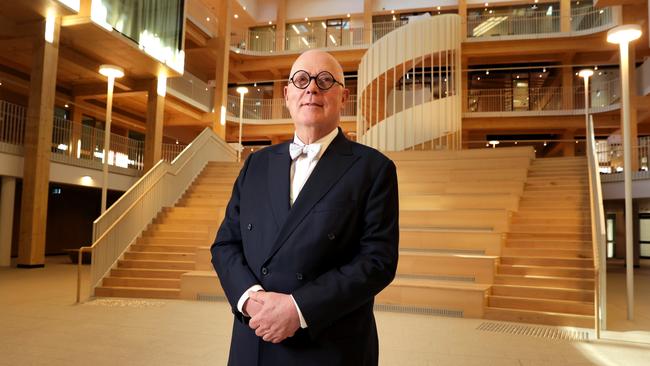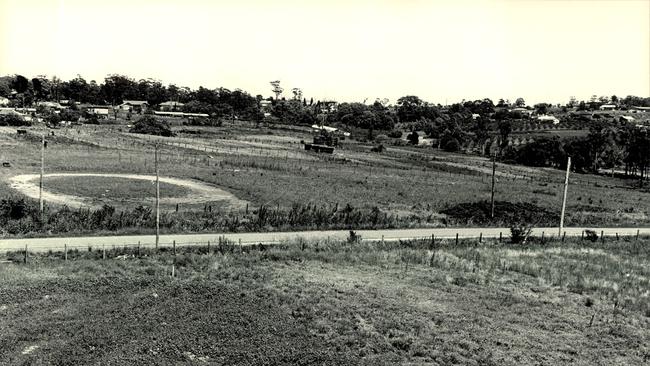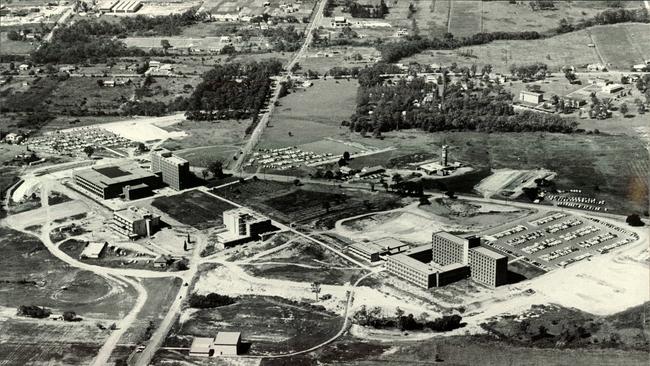Macquarie University take lessons from its 60-year history
Sixty years on, Macquarie University looks back on a history of achievement and plans to recapture its past in the future.

At the Macquarie University campus in northern Sydney’s North Ryde, there’s the constant hum of construction as a new engineering building goes up.
On the hoardings around the site are large black and white photos, dating back more than 60 years when the campus was green fields – small agricultural plots and Italian market gardens supplying Sydney with produce. They progress through the university’s early years, capturing long-haired students, brutalist architecture and the energy of a young campus.
This year is Macquarie’s 60th anniversary and the photos are a marked contrast with the campus of today, which hosts 20 or so technology companies (including Cochlear), has an onsite private hospital owned by the university and a metro station linked to Sydney’s expanding metro network.

Vice-chancellor Bruce Dowton says the university has a string of firsts, which date back to its founding. “This was the first university in Australia to offer daycare for both staff and students with young children to enable women with families to attend university, and the first to offer evening classes in any substantial way,” he says.
Another unique thing about Macquarie is the large business park that sits next door, in addition to the companies based on campus. It was “quite maverick” of the NSW government to decide to co-locate a university with a business park back in the day when the area was being developed, Dowton says.
Another achievement is that Macquarie was the first, and for many years the only, university in Australia to have a woman vice-chancellor, Di Yerbury, who served from 1987 to 2005.
Macquarie was at the head of a new wave of universities established in the 1960s and early 70s that became collectively known as “gum tree” institutions because of the dominant feature of their landscapes.
It was established by a NSW act of parliament in mid-1964, just edging out La Trobe University, whose Victorian act passed at the end of 1964. Both universities began teaching in 1967.

It heralded a new era of government investment in universities that eventually brought higher education to a much larger proportion of the population, and made universities crucial to meeting national skills needs and research objectives.
In keeping with the times, Macquarie’s teaching sought to fulfil the traditional liberal arts vision of a full education, not anchored to a particular discipline or professional outcome, and also to soften the hierarchical distinction between lecturer and student.
In a move radical for Australia, the university initially offered only a single bachelor of arts degree that encompassed the humanities, the sciences and the social sciences, encouraging students to study across disciplines and seek an education in the broadest sense.
“The origin story is an interesting one and distinctive,” Dowton says. It was something he reflected on when he took up the vice-chancellorship 11 years ago.
“We spent a lot of time when I first arrived on trying to distil out what the university is really all about,” he said.
Out of that came a statement the university’s purpose as “service and engagement”.
“We take very seriously the mission we have to serve the society that created us,” he says.
The university has evolved to become like all major Australian universities in offering specialist degrees with a heavy professional emphasis.
But Dowton has long worked to have today’s university reflect its early purpose by bringing together disparate fields – for example, arts, law, science and engineering – in ways that generate new insights and knowledge.
“I’d like to think that we’ve recaptured some of that foundation story of service and engagement, although they didn’t use the words back then,” Dowton says.
One thing he felt had gone off track was Macquarie’s on-campus business park, which he believes “had essentially become a real estate play”, earning money but not sufficiently engaged with the university.
Macquarie decided it wanted all its business tenants to have links with the university – through research or contributing to students’ learning – and is implementing that change.
Ideally, the university likes to see its own spin-out companies, and other tech start-ups, establishing themselves on campus or in the nearby office park. In three years, it has spun out companies worth more than $80m.
One spin-out, MicroBioGen, which specialises in biofuels, makes yeast strains and is responsible for about three-quarters of the US ethanol market. Although MicroBioGen spun out of Macquarie more than 15 years ago, it recently returned to the adjacent office park to be near the ARC Centre of Excellence in Synthetic Biology, based at the university.
Dowton says he believes that 60 years on, it is the right time to look back and learn from Macquaries’s founding years and remind people of its achievements and its future potential. “When you look at what prior (NSW) state governments have done around creating new enterprises largely in the west (of Sydney), it’s disappointing in some ways that they have forgotten that they actually have one here,” he says.




To join the conversation, please log in. Don't have an account? Register
Join the conversation, you are commenting as Logout